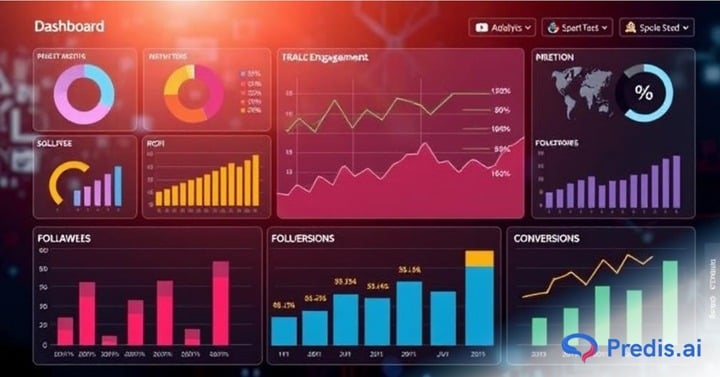In the bustling world of digital marketing, where every dollar spent must yield measurable results, understanding Social Media Return on Investment (ROI) is paramount.
Imagine this: a small boutique coffee shop decides to launch a new Instagram campaign showcasing its unique blends and cozy ambiance. They invest time, effort, and budget into creating compelling content and running targeted ads. But, how do they know if their investment is paying off?
Measuring social media ROI isn’t just about tracking likes and shares—it’s about quantifying how your social media efforts contribute to the bottom line.
Social media isn’t random anymore. It’s not “post and hope.” It’s a measurable channel with clear costs, clear returns, and clear accountability. Whether you’re a small business or a growing brand, understanding your social media ROI is the difference between running campaigns with purpose—and burning time and money on content that doesn’t move the needle.
Here’s the thing: brands in 2025 can’t rely on likes, reach, or vague “brand awareness” claims. With the rise of advanced analytics, better attribution tools, and tighter marketing budgets, you need to know exactly what every post, campaign, and platform is doing for you.
Let’s break it down in the simplest way possible.
What Social Media ROI Actually Means
ROI is the real value you get in return for the time, money, and work you invest into social media.
The formula is simple:
ROI = (Return – Investment) / Investment × 100
Your “return” depends on your goals:
- Revenue from sales
- Leads generated
- App installs
- Website sign-ups
- Booked consultations
- Cost savings
- Brand lift (measured properly, not vaguely)
In 2025, ROI isn’t a single number — it’s a combination of direct and indirect value. The more clearly you define your goals, the more accurate your ROI becomes.
Step 1: Define One Clear Goal Per Campaign
If you don’t know what success looks like, you can’t measure it.
Examples:
- Increase website conversions
- Drive 100 qualified leads
- Boost product sales by 20%
- Improve retention with better customer engagement
- Build awareness for a launch
Avoid vague targets like “get more reach” or “grow page.” Be specific.
Step 2: Track the Right Metrics (No More Vanity Metrics)
In 2025, metrics fall into four buckets:
Engagement Metrics
Comments, saves, shares, replies — these show real interest, not empty reactions.
Conversion Metrics
Link clicks
Add-to-carts
Purchases
Form fills
Bookings
App installs
Customer Value Metrics
Repeat purchases
Lifetime value (LTV)
Retention rate
Community Trust Metrics
User-generated content
Reviews
Referrals
Brand mentions
The mistake most brands make? They judge ROI only by likes. Likes don’t mean action. Saves, shares, clicks, and conversions matter far more.
Step 3: Calculate Your Total Investment
ROI only makes sense when you know your actual costs. Include:
- Team salaries or freelancer fees
- Tools (schedulers, analytics, design apps)
- Ads and boost budgets
- Production costs (shoots, editing, UGC creators)
- Time (yes, time has a cost)
Once you know your total investment, you can measure whether the return is worth it.
Step 4: Measure Your Return Across Multiple Touchpoints
Social media influence rarely happens in one step. People see, explore, compare, then act.
Your returns may include:
Direct revenue
If someone buys directly from a link, the value is clear.
Assisted conversions
Maybe the customer saw your content on Instagram but bought from your website later. This still counts.
Lead value
If a lead becomes a client later, their value matters.
Example: A dental clinic gets a consultation lead worth ₹500 but the final treatment is ₹30,000.
Cost savings
This is often overlooked:
- Fewer support calls because your content answers questions
- Reduced advertising cost because organic content performs well
- Better retention because your community feels connected
Lifetime value
A returning customer is worth more than a one-time buyer.
ROI becomes much more accurate when you consider the full customer journey, not just quick sales.
Step 5: Use a Tracking System That Actually Works
In 2025, the best brands use a combination of:
- UTM links
- Platform insights
- CRM tracking
- Pixel data
- Referral links
- Promo codes
- Booking source tracking
If you don’t tag, track, or measure, you’re operating blindly.
Step 6: Identify What’s Actually Working
Your real power comes from patterns:
- Which platform converts best?
- What content brings leads vs what brings engagement?
- Which creator drives actual sales?
- Which posts get the highest clicks or saves?
- Which campaigns attract high-value customers?
Once you see the patterns, you double down on the content that performs — and cut what doesn’t.
Step 7: Present ROI Clearly to Your Team or Clients
People trust numbers, not noise.
A simple report makes your ROI undeniable:
- Total spend
- Total returns
- % ROI
- Key wins
- What to repeat
- What to avoid
- Recommendations
Even a simple monthly snapshot helps you show real value.
Why Analyze Social Media ROI?
Before we dive into the components, it’s essential to understand why measuring social media ROI matters.
ROI measurement lets you:
- Evaluate Effectiveness: Determine how well social media efforts contribute to your business goals.
- Optimize Strategies: Identify which strategies are most effective and allocate resources accordingly.
- Justify Investments: Provide concrete data to justify social media budgets and expenditures.

Calculating Social Media ROI
Calculating your social media ROI is simple once you’ve figured out your total investment and total return. Use this formula below:
Social media ROI = [(Profit – Total investment)/Total investment]*100
Now that you have understood the formula to calculate your social media ROI, let’s look at some key components and tools to measure ROI.
Components of Social Media ROI Calculation
Calculating social media ROI involves considering multiple factors that contribute to both costs and returns. Here are the main components you should focus on:
| Components | What they involve |
| 1. Goals and Objectives | Brand Awareness, Lead Generation, Sales |
| 2. Costs | Advertising Spend, Content Creation, Labor, Tools & Platforms |
| 3. Revenue Generated | Attributed Sales, Conversion Rates, CLV |
| 4. Metrics and KPIs | Reach & Impressions, Engagement Rate, CTR, Conversion Rate, CPC & CPM |
| 5. Attribution Models | First, last, and multi-touch Attribution |
| 6. Benchmarking and Analysis | Benchmarking, Analysis |
1. Goals and Objectives
Clearly defined goals are the foundation of any ROI calculation. When setting social media goals, it’s essential to align them with broader business objectives to ensure meaningful measurement and alignment with the overall strategy.
Common social media goals include:
Brand Awareness
- Metrics: Increase in followers, reach, and impressions.
- Why It Matters: Growing brand visibility can lead to improved recognition and top-of-mind awareness among your target audience. Leveraging AI Brand Monitoring tools allows businesses to track how their brand is perceived in real time across digital channels. For instance, increasing reach by 20% over a quarter can potentially boost brand recall and consideration.
Lead Generation
- Metrics: Click-throughs, sign-ups, and inquiries.
- Why It Matters: Social media can be a powerful lead-generation tool. Tracking conversions from social media campaigns allows you to assess the effectiveness of lead capture strategies and optimize accordingly.
Sales
- Metrics: Direct revenue generated from social media campaigns.
- Why It Matters: Ultimately, social media efforts should contribute to revenue generation. By tracking sales attributed to social media referrals, businesses can quantify the financial impact of their social media investments.
Whether you’re aiming to increase brand awareness, drive website traffic, or generate leads, aligning social media activities with specific, measurable objectives is essential.
2. Costs
To accurately measure ROI, it’s crucial to account for all costs associated with your social media efforts, such as:
Advertising Spend
- Allocated budget for paid campaigns on platforms like Facebook Ads, Instagram Ads, LinkedIn Ads, etc.
- Monitor campaign performance to optimize spend and maximize ROI.
Content Creation
- Include costs related to producing graphics, videos, written content, and other creative assets.
- Consider outsourcing content creation or investing in tools to streamline production processes.
Labor
- Factor in time and resources spent on managing social media accounts, creating and scheduling posts, engaging with followers, and monitoring analytics.
- Calculate labor costs based on hourly rates or salaries of team members involved in social media management.
Tools and Platforms
- Include costs of social media management tools, analytics platforms, scheduling software, and any other tools used to enhance social media performance.
- Evaluate the ROI of these tools based on their contribution to efficiency, insights gained, and overall campaign effectiveness.
Calculating social media ROI requires meticulous tracking of expenditures. This includes not only direct costs such as advertising spend and content creation expenses but also indirect costs like staff time dedicated to social media management.
3. Revenue Generated
Tracking revenue directly attributable to social media efforts is essential for calculating social media ROI:
Attributed Sales
- Identify sales directly generated from social media referrals, promo codes, or specific campaign links using UTM parameters.
- Use attribution models to link sales back to social media interactions and campaigns (more on that later).
Conversion Rates
- Measure the percentage of social media visitors who convert into customers or take desired actions (e.g., purchases, sign-ups).
- Optimize conversion paths and landing pages to improve conversion rates over time.
Customer Lifetime Value (CLV)
- Calculate the total revenue generated from customers acquired through social media efforts over their lifetime.
- Use CLV insights to prioritize high-value customer segments and tailor social media strategies accordingly.
While attributing revenue directly to your social media efforts can be challenging, it’s crucial to track conversions and sales influenced by social media campaigns. Advanced analytics tools like Google Analytics and CRM integrations can help connect the dots between social media engagement and revenue.
4. Metrics and KPIs
Choosing relevant Key Performance Indicators (KPIs) ensures effective measurement of your social media ROI. Some examples of KPIs and strategies to optimize them include:
Reach and Impressions
- Measure how many people see your content to gauge brand exposure and potential audience size.
- Track trends in reach and impressions to assess the impact of content distribution strategies.
Engagement Rate
- Calculate the percentage of your audience interacting with your content through likes, comments, shares, and clicks.
- Interact with high-engagement posts to foster community interaction and brand advocacy.
Click-Through Rate (CTR)
- Evaluate the percentage of people who click on a link or call to action in your social media posts.
- Optimize CTR by testing different CTAs, visuals, and messaging to encourage clicks.
Conversion Rate
- Measure the percentage of visitors who take the desired action (e.g., make a purchase, or sign up for a newsletter) after clicking through from social media.
- Analyze conversion paths and user behavior to optimize conversion rates and improve campaign effectiveness.
Cost-Per-Click (CPC) or Cost-Per-Impression (CPM)
- Assess the cost efficiency of paid campaigns by calculating the cost per click or cost per thousand impressions.
- Compare CPC or CPM across different platforms and campaigns to allocate budget optimally and maximize ROI.
Selecting the right metrics is key to gauging the true impact of social media on business outcomes.
5. Attribution Models
Attribution models help assign credit to different touchpoints in the customer journey. There are mainly three types of attribution models:
First-Touch Attribution
- Attributes all credit to the first interaction a user had with your brand on social media.
- Useful for understanding initial engagement and brand discovery.
Last-Touch Attribution
- Attributes all credit to the last interaction before a conversion.
- Helps identify the final touchpoints that lead to conversions and sales.
Multi-Touch Attribution
- Assigns credit to multiple touchpoints across the customer journey.
- Provides a holistic view of how different interactions contribute to conversions and revenue.
Whether employing first-touch attribution, last-touch attribution, or multi-touch models, choosing the right approach depends on understanding how customers interact with social media content before making purchasing decisions.
6. Benchmarking and Analysis
Regularly benchmarking performance against industry standards and competitors provides context for interpreting ROI data. Analyzing trends and identifying correlations between social media activities and business outcomes allows for continuous refinement of your strategies.
Benchmarking
- Compare your metrics with industry standards to assess performance and identify areas for improvement.
- A thorough competitor analysis can provide insights into market trends and best practices.
Analysis
- Regularly analyze data to identify trends, strengths, weaknesses, and opportunities for optimization.
- Use data-driven insights to refine social media strategies, allocate resources effectively, and maximize ROI.
By leveraging these components and strategies, businesses can effectively measure social media ROI, justify investments, and optimize digital marketing efforts to achieve sustainable growth and business success.
Tools for Calculating Social Media ROI
Several tools and platforms can streamline the process of evaluating social media ROI, including:
- Google Analytics: Track website traffic, conversions, and revenue from social media referrals.
- Social Media Analytics Tools: Platforms like Facebook Insights, LinkedIn Analytics, and Twitter Analytics provide insights into engagement metrics and audience behavior.
- CRM Systems: Integrate customer relationship management systems to attribute conversions and track customer journeys originating from social media interactions.
Conclusion
Calculating social media ROI empowers businesses to optimize marketing strategies, justify investments, and drive sustainable growth. By leveraging clear goals, comprehensive cost tracking, relevant metrics, effective attribution models, and robust analytical tools, you can unlock the full potential of your social media efforts.
Start implementing these strategies today to elevate your digital marketing success and demonstrate tangible ROI to stakeholders.
When it comes to creating compelling social media content using the power of AI, look no further than Predis.ai. With Predis.ai, you can unleash your creativity by generating stunning images, animations, videos, and music to make your content truly distinctive.
Curious to learn more? Sign up for a free account and begin exploring Predis.ai today!















